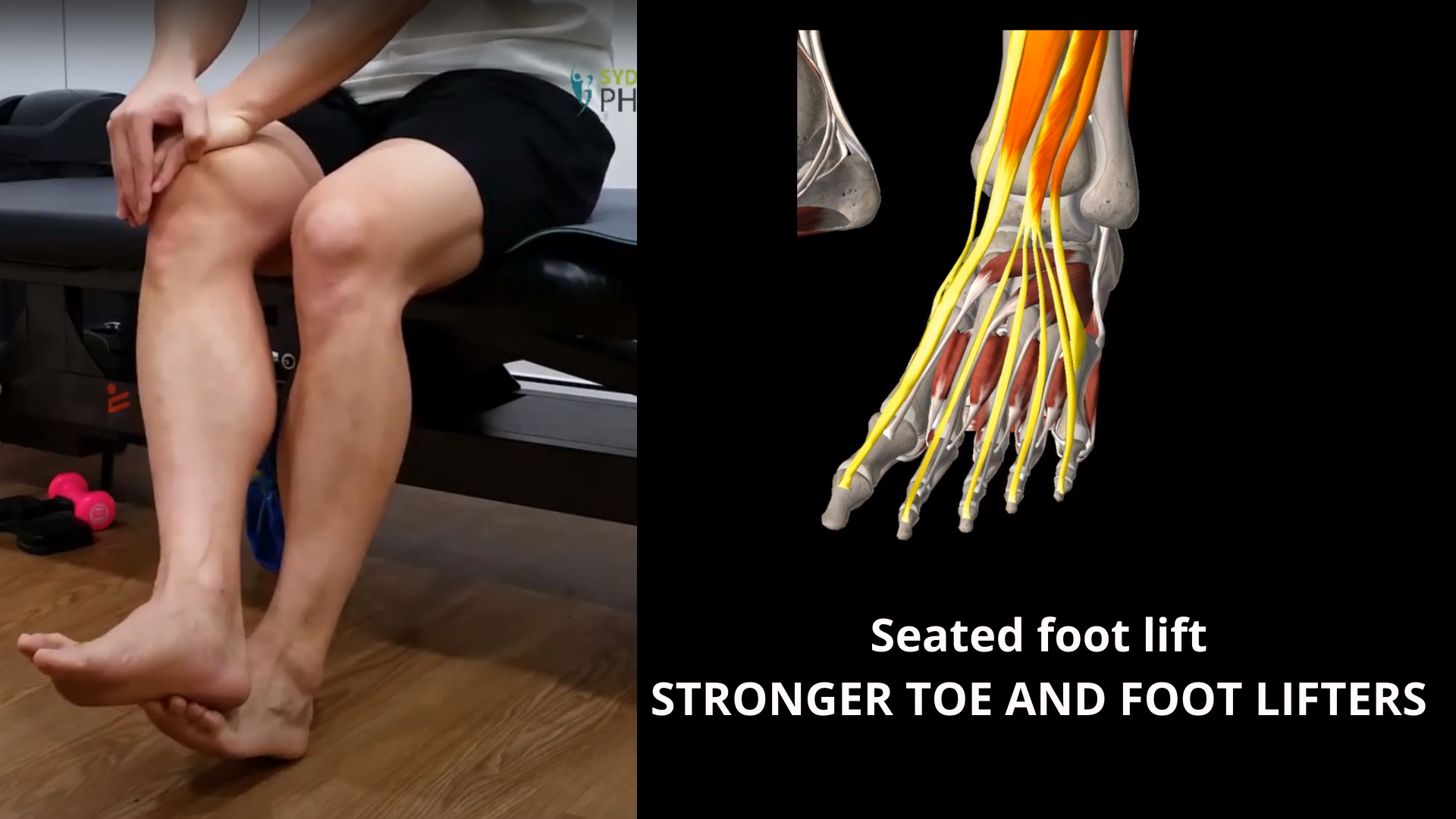Ball Squeeze heel raise
Calf raises with an object squeeze activate the calf muscles while enhancing ankle stability, making it excellent for foot and ankle injury recovery. This exercise improves balance, strengthens the lower leg, and promotes proper alignment, supporting a strong foundation for daily movement and athletic activities.
Neck turning laying down
The neck-turning exercise in a lying-down position gently relieves stiffness from wry neck and serves as an initial movement for whiplash recovery. This light exercise promotes neck mobility, eases muscle tension, and supports gradual improvement in range of motion, ideal for early-stage rehabilitation.
Shoulder pull up
The shoulder pull-up against a resistance band is designed for the final stage of shoulder pain recovery, enhancing strength and stability. This exercise builds shoulder endurance, supports full range of motion, and promotes balanced muscle activation, preparing the shoulder for return to regular activity.
Laying down Deep Neck Flexor
The deep neck flexor activation exercise with chin tucks in supine gently engages the neck muscles, making it ideal for the beginning stage of whiplash recovery. This exercise promotes neck stability, relieves tension, and supports a gradual improvement in neck control and alignment.
Arch inducing squat
Arch-inducing squats target foot muscles to support arch formation, making them beneficial for treating plantar fasciitis and flat feet. This exercise promotes foot stability, reduces strain on the plantar fascia, and helps prevent foot pain, providing a strong foundation for improved lower body alignment.
Eccentric heel lowering
The heel-lowering exercise on a stair step gently elongates the calf muscle, promoting flexibility and supporting recovery from Achilles tendinitis. This exercise reduces tension in the Achilles tendon, enhances calf strength, and aids in healing by gradually improving tendon resilience and mobility.
Lateral step ups
Lateral step-ups target the quadriceps while enhancing pelvic tilt control, making them ideal for building lower body strength and stability. This exercise supports balanced leg strength, improves hip alignment, and promotes better control over pelvic positioning, which is essential for functional movement and posture.
Ankle inversion strengthening
The seated ankle inversion exercise strengthens the ankle’s stabilising muscles, making it ideal for preventing injuries in court and field-based sports. This exercise improves ankle stability, supports better balance, and helps reduce the risk of sprains, providing a strong foundation for dynamic athletic movements.
Seated heel raise
The seated heel-raise exercise is a gentle movement designed for the early stages of Achilles tendon rehabilitation. This light exercise activates the calf muscles, promoting blood flow and gradual strength building, supporting safe and effective recovery of the Achilles tendon.
Seated foot lift
The seated toe-lift exercise targets the muscles at the front of the ankle, enhancing stability and control. This exercise is ideal for improving ankle strength and balance, supporting better movement mechanics, and reducing the risk of ankle-related injuries.
Romanian hamstring dip
The single-leg Romanian deadlift strengthens the hamstrings, glutes, and core while improving balance and stability. Ideal for building lower body strength and enhancing hip control, this exercise promotes proper movement mechanics, reduces injury risk, and supports athletic performance in dynamic activities.
Ankle resisted eversion
The ankle evertor strengthening exercise with a theraband targets the outer ankle muscles, essential for preventing ankle sprains. This exercise improves ankle stability, enhances lateral control, and builds resilience, making it ideal for individuals prone to ankle injuries or those looking to boost lower limb stability.
Trunk rotation stretch
The trunk rotation stretch in the supine position gently releases upper back tension, promoting flexibility and relaxation along the spine. Ideal for relieving stiffness and improving rotational mobility, this stretch supports better posture and reduces upper body discomfort.
Theraband neck forward pull
The theraband neck forward pull exercise builds endurance in the neck muscles, supporting better posture and neck stability. Ideal for individuals looking to strengthen neck control and reduce strain, this exercise promotes sustained muscle endurance, essential for long periods of sitting or desk work.
Trapezius shoulder shrug
Trapezius shoulder shrugs relieve tension in the postural muscles, promoting blood flow and reducing neck pain associated with prolonged sitting. This exercise supports better circulation, eases muscle tightness, and enhances upper body posture, making it ideal for desk workers and individuals with neck discomfort.
Shoulder press
The shoulder press is a powerful exercise for strengthening the shoulder muscles, enhancing upper body stability and endurance. Ideal for building shoulder strength and improving overhead mobility, this movement supports functional strength and promotes balanced muscle development.
Resistance band behind the head pull
The resistance band behind-the-head pull exercise activates postural muscles, helping improve posture by increasing muscle tone and stability in the upper back and shoulders. This exercise supports better alignment, reduces slouching, and promotes a strong, upright posture, making it ideal for combating the effects of prolonged sitting.
Resistance band direct pull back
The resistance band direct pull-back exercise strengthens the muscles at the back of the shoulders, encouraging a naturally better posture. Ideal for counteracting forward shoulder rounding, this exercise improves upper back stability, enhances shoulder alignment, and supports an upright posture.
Resistance band shoulder retraction
The resistance band shoulder retraction exercise targets the upper back and shoulder muscles, helping to alleviate neck and upper back pain and stiffness caused by prolonged computer use. By strengthening postural muscles, this exercise rebalances your posture, promoting alignment and reducing tension.
45 deg shoulder pull down
The 45-degree shoulder pull-down exercise helps create space in the subacromial region, relieving pressure on shoulder structures. Ideal for individuals with shoulder pain, impingement, rotator cuff tears, or frozen shoulder, this movement promotes mobility, reduces discomfort, and supports healthy shoulder function.




















